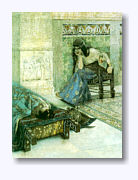At this time there lived Semiramis (Shamiram in Armenian), the queen of Ninevah. Her husband was Ninus, who came to loathe her for her infidelity, and left his country. Semiramis, who had heard about the fame of the handsome Armenian king Ara, lusted after his image and asked him to come to Ninevah and marry her. When Ara refused, she marched her armies towards Armenia.
The battle began when Semiramis arrived in the region called Ararat. She ordered her commanders to capture Ara alive, but he was vanquished and killed by one of her sons. His body was found on the battlefield among the other slain soldiers. In order to calm the Armenians, who wanted to continue the fight to avenge his death, Semiramis said, "I have prayed to the gods to lick his wounds and heal him. Ara will revive."
Semiramis was a sorceress, and she believed in her powers. She was so crazed at his death and desperate for his beauty that she believed she could revive him. When his corpse decayed she became more crazed than before, and had her servants bury it in a deep grave. Dressing one of the men from her retinue of lovers as Ara, she came before the Armenians and said, "Licking his wounds the gods gave life back to Ara, thus fulfilling our deepest desires. Since they have bestowed on us happiness we should exalt them more than before."
She had a new statue erected to the gods and offered them many sacrifices for saving Ara. The people believed that Ara was revived, and Semiramis was saved from another battle waged against her.
In order to eternalize her love for Ara, she named his son Karthos after him, who was born from his wife Nuvard and aged twelve at the time. Although he was so young, she made him ruler of Armenia.
On her way back to Ninevah, the proud Assyrian queen traveled by the eastern shores of Lake Van. Struck by the beauty of the region and bringing thousands of workers and many architects, she had a magnificent summer palace built on the rocky cliffs nearby. (Ed. Note: There is some discrepancy in Khorenatsi's account of the palace and city alluded to Semiramis. The description of the palace walls and a monumental wall with inscriptions described in his account were actually built during the reigns of the Urartian King Menuas and Argishti. Khorenatsi mistakes the palace and new city of Tushpa for one built by Semiramis. Likewise the Semiramis Canal, which was accredited by Khorenatsi as being built under Semiramis' orders, was laid during the Urartu period, on top of earlier 4th-3rd millennium BC canals).
Khorenatsi goes on to relay that Semiramis remained in the city she had built, appointing as her representative in Assyria and Ninevah, Zoroaster, the religious leader and oracle of the Medes, and as such he ruled the country well for a long time.
Ninus did not die in Ninevah, and is not buried in the palace, as it is said, but actually fled to Crete. When her children grew up they wanted to seize Semiramis' throne and confiscate her treasury. They openly accused her of disgraceful deeds. This enraged her, and she had all of her children killed with the exception of the youngest son Ninyas, or "Zamassias". She left her throne and her treasury to her lovers instead.
Therein Zoroaster tried to usurp the throne, and in the ensuing battle Semiramis was defeated which caused her to flee to Armenia. Her son Ninyas saw his chance, and killing her became the ruler of the kingdom. Ara (Karthos, the renamed son of Ara) also died in during the battle, leaving a son named Anushavan.
Another version of the story of Ara Geghetsik and Semiramis is tied to the mountain that bears Ara's name (Arai Lehr). This version has Ara being cast upon the mountain by Semiramis after he spurns her advances. Semiramis, skilled in black magic, conjured the forces of the night to throw him into the void, and when he landed, his body sank onto the top of the mount, giving it its present contour. Yet another tale says that when Ara died, and Semiramis had him buried at the foot of the mountain, his spirit rose, forming the top of the mountain into his sleeping likeness. The top of the mountain does resemble the contour of a man's face.



